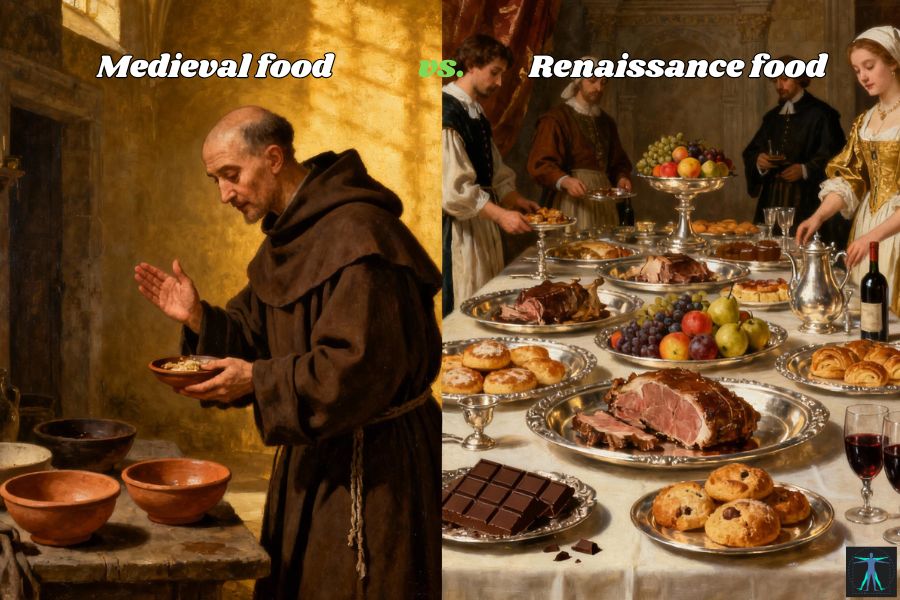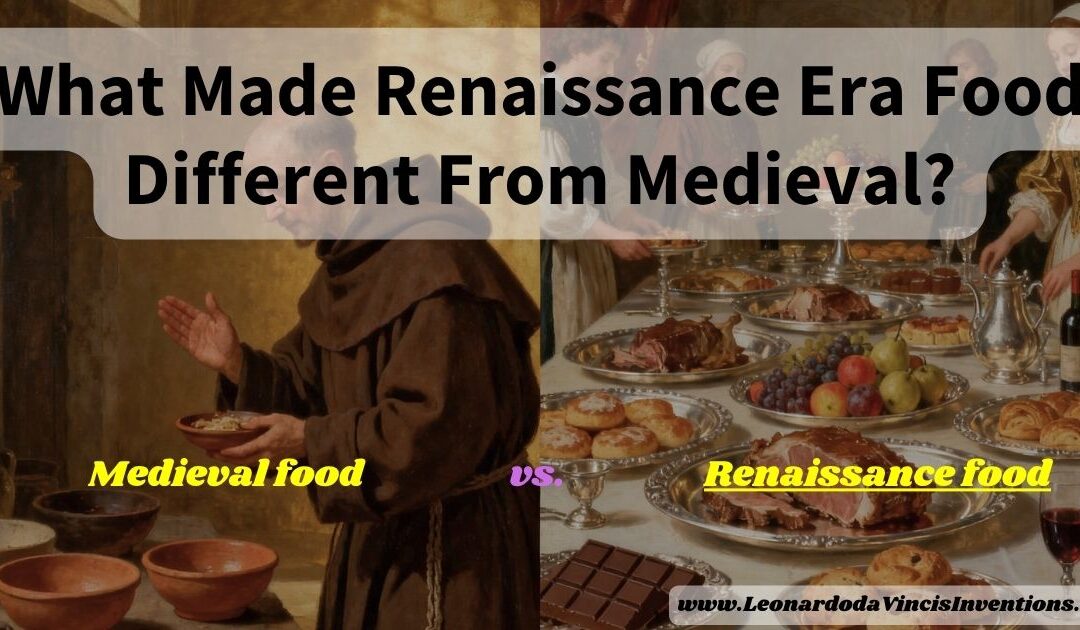
The food of the Renaissance era truly diverged from the simple, limited diets of medieval times. Suddenly, culinary exploration and social dining became the norm.
The biggest changes? New World ingredients like tomatoes and chocolate, the rise of sugar as a sweetener, and meals transforming from basic sustenance into elaborate displays of wealth and status.
During the Renaissance, food evolved into an art form and a status symbol, rather than just a means of survival. The growing middle class began to acquire spices and cooking techniques that were once reserved for the nobility.
The medieval period was characterized by the Catholic Church’s rules for modest eating and a rigid feudal system that limited most people’s food choices to a bleak range. Then came the Renaissance, and suddenly, luxury and experimentation were in style.
The Age of Exploration introduced new staples, including potatoes, tomatoes, and chocolate. These ingredients revolutionized European diets.
This revolution touched everything—what proteins people ate, how bread marked social class, and how fresh produce from faraway places changed daily meals. Dining turned into a cultural event, not just a necessity.
The Transformation of Meat and Protein in Renaissance Era Food
Renaissance cooks began to move away from salted, preserved meats. Fresh preparations and exotic game birds stole the spotlight at noble tables.
Roasted peacock and swan became showpieces. Fresh fish started to replace salted versions, especially for those who could afford it.
From Preserved Pork to Fresh Roasted Meat: A Culinary Revolution
Medieval diets leaned heavily on preserved pork, bacon, and salted meats. That was mostly because storage options were limited.
With the Renaissance came better preservation and supply chains. Suddenly, cooks could serve fresh roasted meat much more often.
Fresh roasts became the stars of Renaissance banquets. Wealthy families flaunted their status with elaborate dishes of beef, veal, and mutton.
These new dishes required skilled cooks and the latest techniques. Improved ovens and equipment enabled the development of more flavorful and visually appealing presentations.
Salt still costs a lot, so preserved meats were pricey and tricky. Fresh meat became a symbol of sophistication among the upper crust.
Exotic Game Birds Replace Medieval Staples: Peacock, Swan, and Pheasant on Noble Tables
The nobility ditched simple chicken and duck for dramatic game birds. Peacock, swan, and pheasant became must-haves for aristocratic feasts.
Cooks would re-feather peacocks after roasting them, turning dinner into a visual spectacle. Swans and cranes made appearances at the grandest banquets.
Pheasant and partridge were more practical but still impressive. They tasted great and were easier for kitchen staff to manage.
Hosting exotic game birds showcased artistry and wealth. It was all about making a statement—look at what I can hunt, look at what I can serve.
The Rise of Fresh Fish vs. Salted Fish: Cod, Salmon, and Sturgeon
Medieval tables were loaded with salted cod and herring. As transport improved, fresh fish became the new favorite for those who could get it.
Salmon gained popularity for its rich flavor and attractive appearance on the table. Sturgeon, especially its caviar, became a delicacy among the wealthy.
Fresh trout and pike showed up often at noble feasts. Coastal folks enjoyed oysters, mussels, and other shellfish. Sometimes, even porpoise and whale made an appearance at the most lavish spreads.
Preparing fresh fish took real skill. Renaissance cooks experimented with sauces and new methods to bring out the best in these premium proteins.
Wild Game and Unusual Proteins: Venison, Boar, and Even Dormice
Venison and wild boar were top prizes for Renaissance hunters. Serving these meats showed off your access to hunting grounds and noble connections.
Some tables even featured dormice, hedgehogs, or beavers. That might sound strange now, but back then, it was all about culinary adventure and trying something new.
Rabbit and hare were a bit more common and bridged the gap between everyday and exotic. Middle-class kitchens often included these wild proteins in their meals.
Turkey Arrives: How New World Poultry Changed Renaissance Era Food Forever
Turkey changed everything after Spanish explorers brought it back from the Americas. This large bird provided ample meat for growing households.
Its size made it perfect for grand presentations. Renaissance cooks developed new methods for preparing turkey, distinct from traditional European poultry recipes.
Turkey’s arrival kicked off a global culinary exchange. It effectively summarized how Renaissance-era food culture began to evolve as exploration introduced new flavors and ideas.
Bread, Grains, and the Social Hierarchy of Renaissance Era Food
Bread wasn’t just food anymore—it became a marker of social status. The type of grain, how it was prepared, and the final bread all said a lot about who you were.
White Bread vs. Brown Bread: Manchet, Rye, and the Class Divide
White bread dominated the tables of the rich. The nobility went for fine white bread made from the best flour, drawing a clear line between classes.
Manchet was the bread of luxury. Aristocrats served manchet at banquets, showing off their wealth with every slice.
Meanwhile, the lower classes ate rye and mixed-grain breads. Darker, more nutritious, but definitely not a status symbol. The way bread was ground and baked mattered for both nutrition and social standing.
The Pasta Revolution: Tagliatelle, Ravioli, and Tortellini Enter European Cuisine
Tagliatelle, ravioli, and tortellini emerged as sophisticated new grain dishes. Italian cooks crafted these pastas to highlight their culinary skills and ingredients.
Making these pastas took refined flour and real technique. Noble households hired skilled cooks to create filled pastas with cheese and roasted meats.
The pasta craze spread from Italy through trade. Wealthy merchants brought these dishes to other courts, turning wheat into edible art.
Barley, Oats, and Millet: Medieval Porridge Gives Way to Renaissance Refinement
Barley, oats, and millet have been elevated from basic porridge to fancier dishes. Gruel was out, and seasoned, textured grain sides were in.
Cooks started adding vegetables like onions and garlic to these grains. The result? More complex recipes and a move away from just boiling everything.
The upper classes treated these grains as side dishes, not main courses. It’s a testament to how Renaissance cuisine elevated even humble ingredients.
Rice and Wheat Flour: Luxury Grains That Defined Renaissance Era Food
Rice arrived in the Mediterranean region via the trade route as a highly valued exotic luxury. The wealthy used it in sweet dishes and elaborate sides, setting it apart from everyday wheat.
Wheat flour quality mattered more than almost anything else. The whitest, finest flour produced the best breads and pastries for noble tables.
Processing and transporting these grains is costly. Serving them showed off wealth and access to trade.
How Bread Quality Signaled Status: From Black Bread to Aristocratic Manchet
Black bread sat at the bottom of the social ladder. Made from coarse grains, it was basic fuel for laborers and peasants who couldn’t afford better.
Bread was a staple in Tudor times and was eaten by everyone; however, the quality gap between classes was immense.
Aristocratic manchet needed skilled bakers and pricey ingredients. It went hand in hand with fine meats, such as venison, at feasts—luxury foods working together to showcase status.
Fresh Produce and New World Ingredients Transform Renaissance Era Food
New ingredients from the Americas began to appear during the Renaissance, disrupting traditional European fruit and vegetable varieties. Root vegetables remained important, but tomatoes and potatoes gradually made their way into kitchens, changing the culinary landscape.
Root Vegetables vs. Leafy Greens: Turnips, Carrots, and the Food Hierarchy
Root vegetables were everywhere. Turnips kept peasants going, while carrots gained favor with wealthier folks for their sweetness and color.
Parsnips and rutabagas helped people survive winter. These veggies stored well, making them indispensable during the cold months.
Leafy greens, such as cabbage, lettuce, and watercress, hold a distinct place in the food hierarchy. Cabbage was for the masses, often pickled into sauerkraut to extend its shelf life.
Wealthy Renaissance diners reached for delicate greens like watercress and the first spinach. These fresh flavors spoke to their love of sophistication, setting their meals apart.
Preparation styles split along class lines. Peasants boiled roots into thick stews with the odd scrap of bacon, while the rich enjoyed fancy versions spiced up with exotic seasonings.
Seasonal Produce and Preserved Fruits: Apples, Pears, and Candied Delicacies
Fresh fruit eating followed the seasons during the Renaissance. Apples and pears filled autumn baskets, giving people crucial vitamins before winter set in.
People used preservation techniques to transform seasonal abundance into treats that could be enjoyed throughout the year. Wealthy households made candied fruits with imported sugar, transforming everyday apples into prized sweets.
| Preservation Method | Common Fruits | Cherries, oranges, and lemons |
|---|---|---|
| Dried | Apples, pears, plums | All classes |
| Candied | Cherries, oranges, lemons | Wealthy only |
| In syrup | Peaches, pears | Upper class |
Seasonal produce included strawberries, cherries, and early summer berries. These delicate fruits showed up fresh at wealthy feasts, but only for a short time each year.
Grapes played two roles—people ate them fresh and used them for wine. Both white and red grapes thrived in Mediterranean regions, fueling local economies.
The Arrival of Tomatoes and Potatoes: Exotic Foods That Changed Everything
Tomatoes appeared in Europe in the mid-16th century, but most folks saw them as decorative oddities. Wealthy Europeans cultivated these unusual plants in their gardens, not in their kitchens.
People initially distrusted tomatoes because they resembled poisonous nightshades. The introduction of New World ingredients, such as tomatoes, had a lasting impact on Renaissance cuisine, but it took some time for cooks to adapt to them.
Potatoes also met with skepticism, despite being a nutritious food. Farmers in Europe stuck to familiar roots, such as turnips and parsnips, instead of these new tubers.
Change came slowly through the late Renaissance. Italian cooks started using tomatoes in sauces, laying the groundwork for what we call modern cuisine.
Spanish and Portuguese explorers brought these foods through their trade networks. Still, it took generations for people to embrace them truly.
Mediterranean Flavors: Artichokes, Fennel, and Fresh Herbs in Renaissance Cooking
Artichokes gained significant value in Italian Renaissance kitchens. Wealthy tables featured these Mediterranean vegetables, accompanied by olive oil and fresh herbs.
Fennel is offered in both bulb and seed form for cooking. Cooks used the bulbs as vegetables and ground the seeds into spice for roasted meats.
Fresh herbs like basil, rosemary, thyme, and sage brought simple ingredients to life. Monastery and castle gardens across Europe grew these herbs.
Italian cooks in the Renaissance combined herbs to enhance, rather than mask, natural flavors. That approach stood out in comparison to medieval cooking, which relied heavily on imported spices.
Mediterranean cooking styles spread north through trade. French and English kitchens gradually adopted Italian methods of preparing vegetables and herbs.
Beans, Peas, and Legumes: From Peasant Staples to Refined Renaissance Era Food
Beans and peas crossed class lines in the Renaissance. Poor families relied on these protein-rich foods, while the wealthy incorporated them into elaborate dishes.
Fava beans led the way in early Renaissance gardens, long before American varieties arrived. When people combined these hardy beans with grains, they got a solid protein boost.
Lentils and chickpeas frequently appeared in Mediterranean kitchens. Cooks flavored them with olive oil, garlic, and fresh herbs instead of just boiling them plain.
How people prepared legumes said more about class than the ingredients themselves. Peasants made basic porridge from dried peas, while aristocrats enjoyed them with pricey spices and bits of roasted meat.
Gardeners grew fresh peas as a luxury springtime treat. Wealthy tables across Europe celebrated these tender pods as a sign of seasonal plenty.
Frequently Asked Questions
Renaissance food differed from medieval meals due to the introduction of new ingredients, such as sugar and tomatoes, as well as more sophisticated cooking and presentation techniques. People enjoyed a greater variety and developed dining habits that showcased both their nutritional needs and social status.
What food did they eat during the Renaissance?
Renaissance folks ate bread, meat, and vegetables as staple foods. The wealthy went all out with exotic spices, sugar, and fancy dishes at banquets.
Exploration brought in new foods. Tomatoes, peppers, and chocolate arrived in the New World from the Old World in the 16th century.
The middle class got access to better ingredients than before. They could afford improved cooking and more variety than medieval peasants ever dreamed of.
What did people in the Renaissance eat for breakfast?
Breakfast in the Renaissance was usually simple. Most people ate bread, porridge, or leftovers from the day before.
The wealthy might add cheese, eggs, or a bit of meat. Breakfast wasn’t the main meal—people didn’t fuss over it.
The big meal happened at midday. Evening meals were lighter, especially compared to lunch.
What was the most common food eaten in medieval times?
Bread was the backbone of the medieval diet. Porridge from grains was another staple for most families.
Vegetables like cabbage, onions, and turnips appeared frequently. The peasants and commoners were often limited to a monotonous and unappetizing diet.
Meat is too expensive for most people, so only the wealthy can afford to eat it regularly. Commoners might get pork, chicken, or fish when they could.
What was Leonardo da Vinci’s favorite food?
Leonardo da Vinci liked simple, light meals that wouldn’t slow him down. He ate vegetables, fruit, and usually skipped heavy meat dishes.
Records say he enjoyed minestrone and fresh bread. Da Vinci thought that overeating dulled the mind and hurt creativity.
He appreciated a glass of wine with meals, but only in moderation. His eating habits matched Renaissance ideas about balance and self-control.
What did people drink in the Renaissance?
Water wasn’t always safe, so people turned to ale, beer, and wine. Alcoholic drinks were safer than questionable water sources.
The wealthy enjoyed imported wines and special drinks. Sugar became more widely available and was used to sweeten beverages.
People drank milk fresh when they could get it. Herbal teas and fruit juices were also on the menu, if they were lucky.
What did food look like in the 1500s?
Food presentation became much fancier during the 1500s. The Renaissance introduced haute cuisine, characterized by more intricate preparations and elaborate displays.
Wealthy families often took pride in presenting their meals in elaborate and decorative ways. Sugar sculptures and ornate pastries typically sat at the center of the table as eye-catching centerpieces.
The colors on the plate started to pop more, thanks to the addition of new spices and ingredients. Tomatoes and peppers arrived, adding reds that people hadn’t seen before.
Formal dinners typically consisted of several courses, served one after another. Hosts arranged each dish to impress their guests and show off a bit—maybe even a lot—of wealth and taste.




 Leonardo Bianchi,
the creator of Leonardo da Vinci's Inventions.
Thank you for visiting
Leonardo Bianchi,
the creator of Leonardo da Vinci's Inventions.
Thank you for visiting